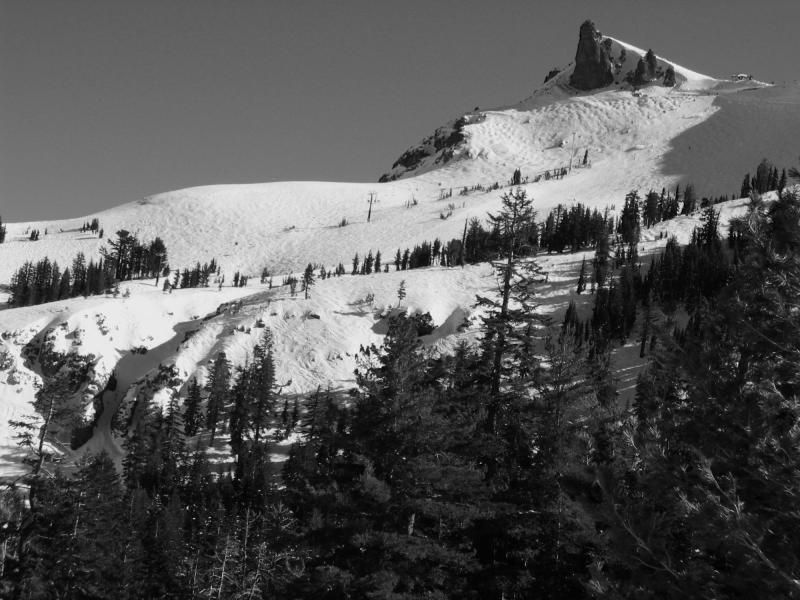This is one of my favorite places of all time. I have a few, believe me, but this place is special. This is Kirkwood. Specifically, this is the top of the mountain, the double-black diamond lift, The Wall. The top of the lift (at the upper right of the photo) sits at about 9400 feet above sea level, with Thimble Peak above it towering to over 9800. I've skied here most of my life and if I'm extraordinarily lucky, I'll be skiing here with my kid when I'm my dad's age.
Oh yeah, the "Waterfall" part is that chute in the lower left, just above the trees. Sking down that is like skiing over a frozen waterfall. In fact, at some point during the year, it probably is a waterfall.
The first thing you might notice about this photo is that it's in black-and-white. I'm never quite sure what to say when people ask me, "Do you have a black-and-white digital camera?". The short answer is that you can take any photo you want and make it black-and-white (BW). Whether that photo would be interesting as a BW image is a totally different question.
Ansel Adams had true gift. He was able to take the imaging technology available to him (and, indeed, invent some more) to bring out the most detail, and create the most interesting and beautiful images ever printed in silver. The technology available to me is somewhat different. Neither better nor worse, it's an instrument that I know how to play, and Ansel wrote some of the best songs.
There are many of ways to make a color image BW, and the most common is to desaturate the image. When you tell your camera to shoot in BW mode, you're simply telling it not to collect any color data, only brightness data. Similarly, you can open your color image in your favorite imaging program and use the command "Make Black and White" (aka Image Mode->Greyscale). All that does is discard the color data. This works, but when you hold your picture up next to an Ansel Adams shot, something is missing. Contrast. Not MORE contrast, just DIFFERENT contrast. In Ansel's shot, for example, blacks might be darker in some spots than they should be, and the sky might be dark grey (even though it was a bright blue when he shot it), but every inch of the photograph contains the sharpest detail. When he was shooting on film and printing on paper, he used different color filters to bring about interesting contrast levels and to enhance detail in difficult lighting conditions.
If you have Photoshop, you can do something similar using this method I learned from The Photoshop CS Book for Digital Photographers, by Scott Kelby:
- Select the "Channels" pallet, or select "Channels" from the "Window" menu.
- Notice that your image is made up of three channels: red, green, and blue. Click on each of those channels in turn, and you'll see your image revealed in three different BW contrast levels.
- Click on the one you like the best, Select All, Copy, and Paste it into a new document.
That's it. When Ansel put a red filter in front of his lens, he didn't add red, he removed green. This process does just about the same thing by removing two of the three colors that make up your image. Next, try combining two channels to build your BW photo. Try using one channel for the sky and the clouds, and another channel for the foreground.
If you like the way your photo came out, thank Ansel Adams and Scott Kelby; two masters of their artform.

